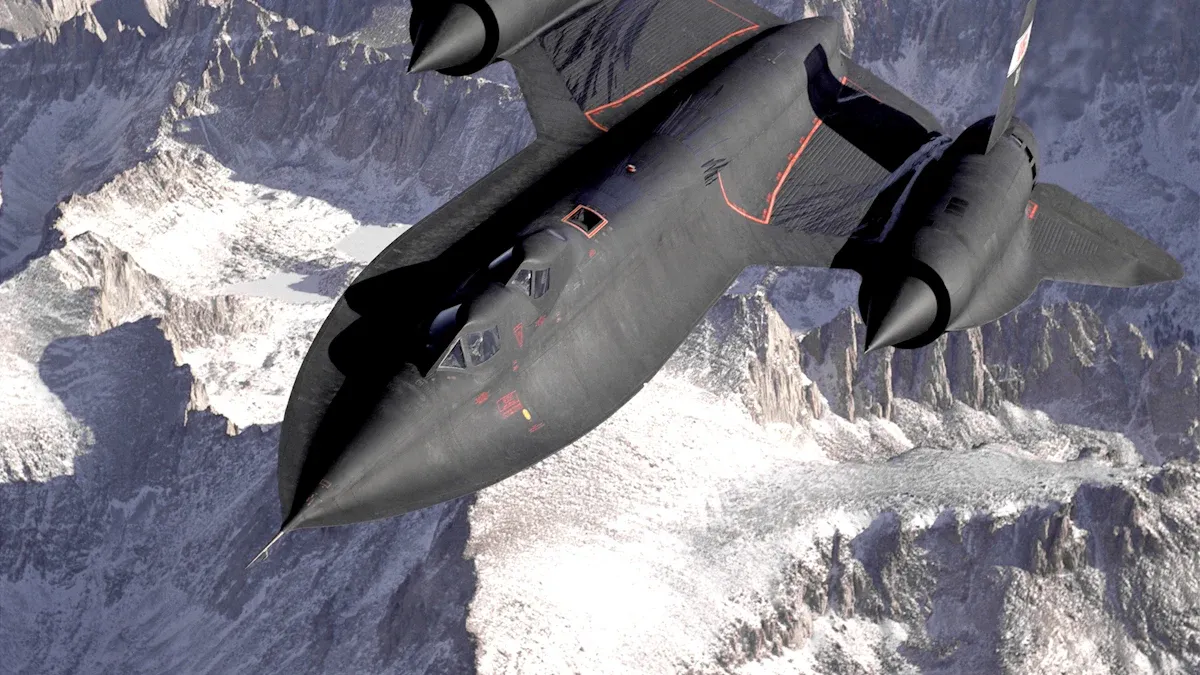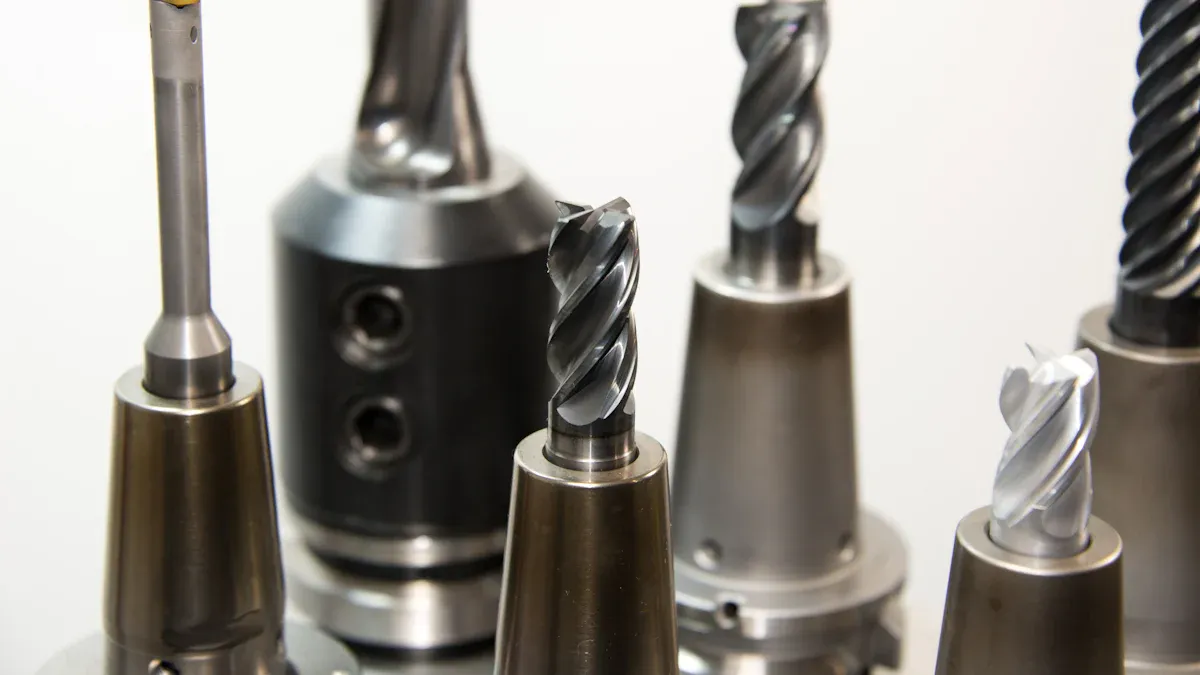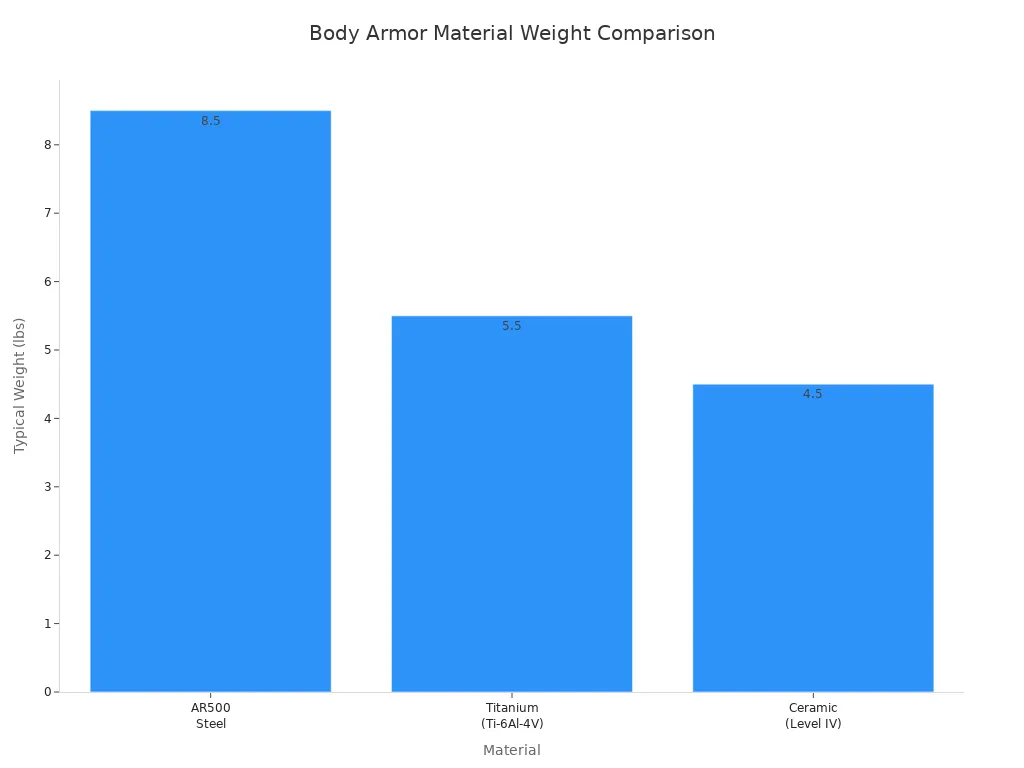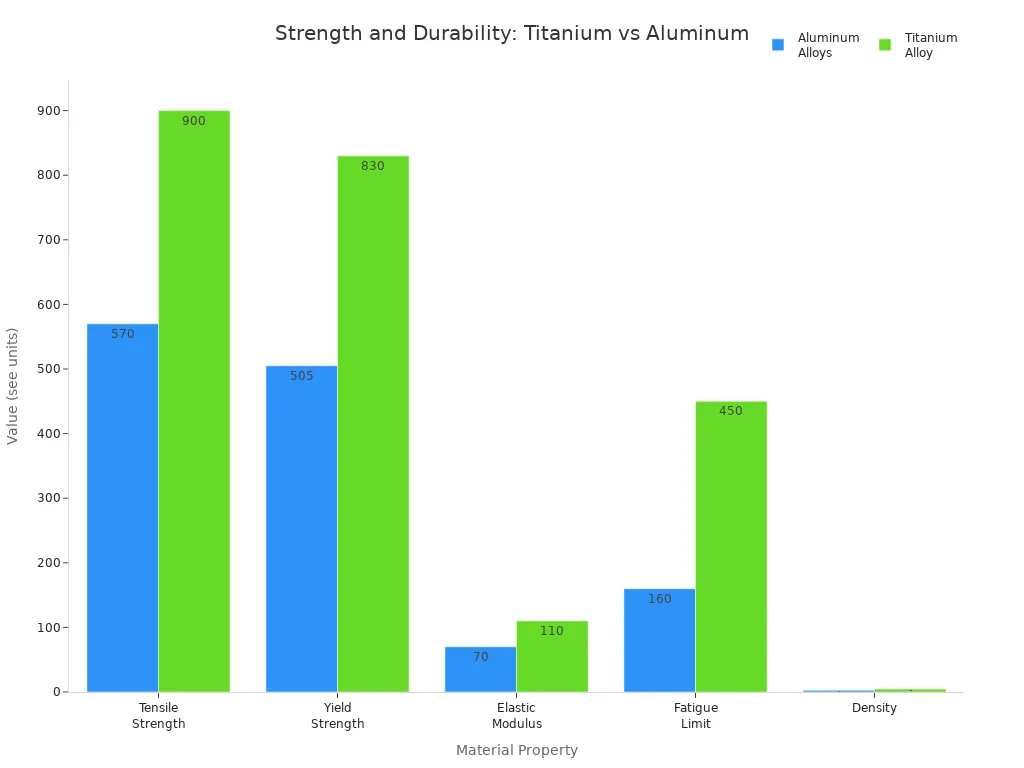
Titanium alloy stands out in defense sectors for its unique combination of strength, light weight, and resistance to extreme conditions. Modern military aircraft rely on this material for critical components, with titanium alloys making up about 30% of jet engine materials and holding a substantial share in structures of advanced fighter jets like the F-35 Lightning II.
The global titanium alloy market reached USD 4,512.2 million in 2024, with North America accounting for more than 40% of revenue, driven by military and aerospace demand.
| Metric | Value/Description |
|---|---|
| Global Titanium Alloy Market (2024) | USD 4,512.2 million |
| North America Market Share (2024) | More than 40% of global revenue |
| Growth Drivers | Aerospace and military industries, technical innovation |
Key Takeaways
- Titanium alloy offers a unique mix of high strength and light weight, making military vehicles and aircraft stronger, faster, and more fuel-efficient.
- Its excellent resistance to corrosion and high temperatures ensures military equipment lasts longer and needs less maintenance, even in harsh environments like seawater and battlefields.
- Titanium alloys provide superior durability and fatigue resistance, allowing critical parts to withstand repeated stress and extend their service life.
- The material is widely used in aircraft, naval ships, armored vehicles, weapons, and personal protective gear, improving performance, protection, and mobility.
- Despite higher upfront costs, titanium alloy’s long-term benefits like reduced repairs, enhanced reliability, and advanced manufacturing methods make it a cost-effective choice for defense systems.
Titanium Alloy Properties for Defense

Strength-to-Weight Ratio
Titanium alloy delivers an exceptional strength-to-weight ratio, which is a critical factor in defense engineering. This property allows designers to create lighter vehicles and aircraft without sacrificing structural integrity or performance. The following table compares the tensile strength and density of titanium alloy with other common metals used in defense:
| Metal Type | Tensile Strength (MPa) | Density (kg/m³) | Strength-to-Weight Advantage |
|---|---|---|---|
| Ti-6Al-4V (Titanium) | ~1000 | ~4420 | Higher strength-to-weight ratio than stainless steel and aluminum alloys |
| Stainless Steel (316) | 570 | 8000 | Heavier and lower tensile strength compared to titanium alloys |
| Aluminum Alloy (6061) | 310 | 2700 | Lighter but lower tensile strength than titanium alloys |
This data highlights how titanium alloy, especially Ti-6Al-4V, combines high tensile strength with moderate density. Military aircraft such as the F-22 Raptor and F-35 Lightning II use large amounts of titanium alloy in their airframes and engines. The high strength-to-weight ratio enables these aircraft to achieve greater agility, improved fuel efficiency, and increased payload capacity. Armored vehicles also benefit from titanium alloy, as it provides robust protection while reducing overall weight, which enhances mobility and survivability on the battlefield.
Titanium alloy’s strength-to-weight advantage has driven its adoption in military aviation since the 1960s. Components such as landing gear, engine parts, and ballistic protection panels rely on this property to withstand extreme stresses during operation.
Corrosion Resistance
Corrosion resistance is another key property that sets titanium alloy apart in defense applications. Titanium forms a stable oxide layer on its surface, which protects it from harsh environments, including saltwater and battlefield conditions. This natural barrier ensures that titanium alloy components maintain their structural integrity over time, even when exposed to corrosive agents.
| Aspect of Corrosion Resistance | Contribution to Military Equipment Longevity |
|---|---|
| Natural oxide layer protection | Shields titanium alloy from harsh, corrosive environments such as saltwater and high temperatures |
| Structural integrity retention | Maintains strength of aircraft airframes, landing gear, naval vessels, and armor plating over time |
| Reduced maintenance needs | Lowers frequency of repairs and associated costs, enhancing operational readiness |
| Thermal stability | Supports performance in high-temperature environments, ensuring durability |
| Lightweight and strong armor plating | Provides superior protection while allowing mobility, contributing to longer service life |
Naval vessels and submarines use titanium alloy for critical components because it resists seawater corrosion far better than steel or aluminum. This resistance reduces maintenance requirements and extends the operational life of military equipment. On the battlefield, titanium alloy armor plating maintains its strength and durability, even after prolonged exposure to moisture, mud, and chemicals. The result is improved reliability and lower lifecycle costs for defense systems.
Titanium alloy’s corrosion resistance minimizes the need for frequent repairs and replacements, which enhances operational efficiency and readiness in demanding military environments.
High-Temperature Stability
Military equipment often operates under extreme thermal conditions. Titanium alloy maintains its mechanical properties at elevated temperatures, making it suitable for use in jet engines, missile components, and high-speed aircraft. Commercially pure titanium can withstand continuous use up to 427°C (800°F), while advanced near-α titanium alloys such as IMI-834 and Ti-1100 can operate at temperatures approaching 600°C.
| Near-α Titanium Alloy | Maximum Service Temperature |
|---|---|
| IMI-834 | ~600°C |
| Ti-1100 | ~600°C |
| BT-36 | ~600°C |
| Ti600 | ~600°C |
Engineers have developed titanium alloys with optimized microstructures to retain high strength and plasticity at these temperatures. For example, Ti-6Al-4V-2Mo-2Fe maintains a yield strength above 1340 MPa after annealing at 500-550°C. This stability ensures that critical components do not lose strength or deform during high-speed flight or intense combat operations.
Titanium alloy’s ability to withstand high temperatures, combined with its strength and corrosion resistance, makes it indispensable for modern defense systems that demand reliability in the harshest environments.
Durability and Fatigue Resistance
Durability and fatigue resistance define the operational lifespan of military hardware. Titanium alloy stands out in these areas, making it a preferred material for demanding defense applications. Military engineers select titanium alloy for its ability to withstand repeated mechanical stress without failure. This property proves essential in components exposed to constant vibration, impact, and load cycles, such as aircraft wings, landing gear, and engine parts.
Ti-6Al-4V, a widely used titanium alloy, demonstrates excellent fatigue resistance and durability. It retains strength and stiffness at temperatures up to 1000°F (540°C), outperforming aluminum alloys in extreme environments. Military aircraft like the SR-71 Blackbird rely on this alloy for critical components that must endure high stress and temperature fluctuations. The density of Ti-6Al-4V is about 66% that of steel, which provides a favorable strength-to-weight ratio and enhances fatigue performance.
Fatigue resistance in titanium alloys depends on microstructural control during manufacturing. Engineers have found that refining the microstructure, especially by reducing the α lath thickness, can increase the fatigue endurance limit by approximately 20%. Advanced processing techniques, such as electron beam melting, minimize residual stresses and internal defects. Stress relief heat treatments further improve fatigue strength, sometimes replacing more expensive processes like hot isostatic pressing. These methods ensure that military-grade titanium alloys achieve superior fatigue resistance, even under extreme operational conditions.
The TC17 titanium alloy, used in military aviation engine components, offers high strength, fracture toughness, and outstanding fatigue properties. High-cycle fatigue testing reveals that fatigue crack initiation accounts for over 85% of the total fatigue life. Cracks often begin at specific microstructural features, such as cleavage facets and phase boundaries. By controlling these features, engineers can extend the service life of critical components.
Titanium alloys meet very high cycle fatigue (VHCF) requirements, often set at 10^9 cycles. This endurance far exceeds that of iron-based and nickel-based superalloys, which typically reach 10^7 cycles. As a result, titanium components in military hardware can withstand more load cycles before failure. The superior fatigue and crack resistance of titanium alloys allow parts to endure repetitive mechanical stress, enhancing long-term reliability.
Titanium alloys offer several advantages for military hardware durability:
- Extended fatigue life, enabling components to survive billions of load cycles.
- Superior corrosion resistance, reducing degradation in harsh environments.
- High strength-to-weight ratio, improving performance without adding unnecessary mass.
- Reduced maintenance frequency, thanks to longer-lasting components.
Military organizations benefit from these properties through longer maintenance intervals and improved reliability. Titanium alloy components require fewer repairs and replacements, which reduces downtime and operational costs. These advantages explain why titanium alloys have replaced other materials in critical aerospace parts, such as fan and compressor disks, blades, and casings.
Titanium Alloy Applications in Military Systems

Aircraft and Aerospace
Military aircraft designers rely on titanium alloy to achieve superior performance and survivability. Titanium alloys provide strength comparable to steel at nearly half the weight, which reduces aircraft mass and improves fuel efficiency. Their corrosion resistance extends the lifespan of critical components, while high-temperature stability makes them ideal for jet engines and other parts exposed to extreme heat. Superior fatigue resistance and fracture toughness help prevent structural failure under repeated stress.
Key benefits of titanium alloys in aerospace include:
- High strength-to-weight ratio for lighter, more agile aircraft
- Corrosion resistance for reduced maintenance and longer service life
- Retention of mechanical properties at temperatures up to 600°C
- Enhanced durability under cyclic loads, improving reliability
- Compatibility with composite materials to prevent galvanic corrosion
| Alloy Type | Key Properties | Aerospace Applications |
|---|---|---|
| α Type (e.g., Ti-5Al-2.5Sn) | High-temp stability, weldability | Compressor stator blades, fuselage frames |
| α+β Type (e.g., Ti-6Al-4V) | Balanced strength, corrosion resistance | Fuselage skin, wing ribs, compressor blades |
| β Type (e.g., Ti-1023) | Ultra-high strength, heat-treatable | Fighter jet landing gears, wing pivots |
Military jets such as the F-35 and F-22 use titanium alloy in airframes, engines, landing gear, and fasteners. This material increases maneuverability and survivability by reducing weight and providing battle damage resistance.
Naval Ships and Submarines
Naval engineers select titanium alloys for critical submarine and ship components due to their unique combination of strength, toughness, and corrosion resistance. Alloys such as Ti-6Al-4V ELI and Ti-5111 are used in submarine hulls, pressure-resistant casings, propellers, and sonar domes. Russian Typhoon-class submarines contain up to 9,000 tons of titanium alloy, demonstrating its importance in deep-sea operations.
Titanium’s non-magnetic nature enhances stealth by reducing detectability. Its high compressive strength allows submarines like the Akula II to operate at greater depths, while corrosion resistance ensures long service life in harsh seawater environments. Components such as whip antennas and communication devices benefit from titanium’s ability to reduce electromagnetic interference, supporting stealth and operational effectiveness.
Titanium alloy hulls and propellers combine mechanical strength with corrosion resistance, boosting propulsion efficiency and stealth for advanced naval platforms.
Armored Vehicles and Land Platforms
Modern armored vehicles benefit from titanium alloy’s ability to reduce weight by 30-40% compared to steel, which improves maneuverability and fuel efficiency. Titanium alloys provide superior impact resistance, structural reliability, and weather resistance, extending vehicle service life and reducing maintenance needs. Modular armor designs using titanium can be quickly installed or adjusted, offering tactical flexibility.
Titanium-based composite armors, such as titanium-steel or titanium-ceramic, enhance penetration resistance beyond traditional steel armor. Vehicles like the M1A2 Abrams and M2 Bradley use titanium alloy for effective ballistic protection at smaller thicknesses, thanks to superior energy absorption. Suspension components made from titanium alloys offer higher fatigue strength, further reducing weight and maintenance costs.
Lightweighting with titanium alloy allows military vehicles to carry additional armor or payload without increasing overall weight. This approach improves speed, range, and adaptability, directly enhancing operational capabilities on the battlefield.
Weapons and Munitions
Titanium alloys play a transformative role in modern weapons and munitions. Defense engineers select titanium for its ability to reduce weight, increase durability, and enhance operational reliability. Many advanced weapon systems now incorporate titanium alloy components, resulting in lighter, more maneuverable, and longer-lasting equipment.
| Weapon/Munition Type | Titanium Alloy Components | Benefits/Notes |
|---|---|---|
| T66 76mm gun | Tailstock, gun mount, barrel, nozzle, launch piston | 93.55kg lighter than steel; improved maneuverability |
| T227 81mm mortar | Seat plate, plug connecting barrel and seat plate | 50% lighter seat plate; mass reduced to 34kg; range increased to 4500m |
| 155mm M777 howitzer | Entire system frame | Nearly 3150kg lighter than predecessor; ~50% weight reduction; improved mobility |
| Japanese 100mm mortar | Seat plate (TA7 alloy) | 10kg lighter than steel plate |
| Russian 152mm double-barreled self-propelled gun | Muzzle brake | High firing rate (15-18 rounds/min); strong firepower and survivability |
| Anti-tank missile (China) | Steering gear and frame (TC9 alloy) | Improved material utilization and cost savings |
| 85 type anti-aircraft machine gun (China) | Brake (TC4 alloy) | Achieved very good results |
| Light flamethrower | Body made of industrial pure titanium or Ti-3Al-2.5V | More than 3kg lighter than steel; range up to 70m |
Many modern firearms also feature titanium alloy parts for enhanced performance:
- Glock 19 Gen 4 uses a titanium nitride coated barrel for durability and friction resistance.
- Sig Sauer P220 features a titanium trigger and hammer, providing strength and lighter weight.
- Smith & Wesson M&P Shield includes a titanium firing pin for improved strength-to-weight ratio.
- Beretta 92FS employs a titanium guide rod, reducing weight and increasing durability.
- Smith & Wesson 340 PD utilizes a titanium alloy cylinder for light weight and corrosion resistance.
Titanium alloys deliver several key advantages in weapon systems:
- Reduced weight improves handling and portability.
- Enhanced corrosion resistance ensures reliability in harsh environments.
- High durability withstands repeated impacts, increasing firearm longevity.
- Reduced vibrations during firing enhance accuracy.
- Thermal stability maintains structural integrity under high heat.
Titanium’s integration into weapons and munitions enables lighter, more adaptable, and longer-lasting systems, supporting rapid deployment and sustained combat effectiveness.
Personal Protective Equipment
Titanium alloys have revolutionized personal protective equipment (PPE) for military personnel. Designers use titanium’s high strength-to-weight ratio to create lightweight body armor and helmets that do not compromise protection. Soldiers benefit from increased mobility and agility, which are critical in dynamic combat environments.
Titanium plates serve as rigid materials in hard body armor systems. These plates offer robust ballistic protection against high-velocity projectiles while remaining significantly lighter than steel. For example, a helmet made from Ti-4Al-3Mn alloy provides the same bulletproof effect as a steel helmet but weighs 0.45kg less. Bulletproof vests using a 25.4mm thick sheet with a Ti-5Al-2.5Sn alloy layer resist shells, grenades, and mine fragments at a mass of only 3.86kg.
CNC machining allows for ergonomic, body-conforming designs that improve comfort and fit. Titanium composites, when combined with ceramics, absorb and dissipate impact energy more effectively. The ceramic layer absorbs the initial impact, while the titanium backing limits deformation and absorbs residual energy, enhancing multi-hit capability and overall durability.
| Material | Typical Weight | Multi-Hit Capability | Relative Cost |
|---|---|---|---|
| AR500 Steel | High (8-9 lbs) | Excellent | Low |
| Titanium (Ti-6Al-4V) | Medium (5-6 lbs) | Very Good | Very High |
| Ceramic (Level IV) | Low (4-5 lbs) | Poor to Fair | High |
Titanium alloy Ti-6Al-4V provides the same ballistic protection as steel at roughly two-thirds the weight. Ceramics offer even greater weight savings but are more brittle and less durable under multiple impacts. Titanium’s toughness and multi-hit resilience make it ideal for specialized lightweight armor.

Titanium alloy PPE balances protection, weight, and durability, enabling soldiers to move faster and stay protected in high-threat environments.
Titanium Alloy Compared to Other Materials
Titanium Alloy vs. Steel
Defense engineers often compare titanium alloy and steel when selecting materials for military systems. Each material offers distinct advantages and limitations. Titanium alloy stands out for its low density and high strength-to-weight ratio, making it ideal for applications where weight reduction is critical. Steel, on the other hand, provides higher hardness, tensile strength, and compressive strength, which makes it the preferred choice for heavy-duty ballistic protection and primary armor.
| Property | Titanium Alloy (e.g., Grade 5) | Steel (High-Strength Alloy) |
|---|---|---|
| Density | ~4.5 g/cm³ (about 45% lighter) | ~7.85 g/cm³ |
| Tensile Strength | ~1000–1100 MPa | ~1200–2200 MPa |
| Yield Strength | ~828 MPa | ~500–1000+ MPa |
| Compressive Strength | Moderate | High |
| Hardness | Softer than hardened steel | Generally harder |
| Modulus of Elasticity | ~116 GPa (more flexible) | ~200 GPa (stiffer) |
| Strength-to-Weight | Excellent | Moderate |
Titanium alloy’s lower density allows for lighter vehicles and equipment, which improves mobility and fuel efficiency. Steel’s higher hardness and impact toughness deliver superior stopping power against high-velocity projectiles, making it the standard for main battle tank armor and fortifications.
- Titanium alloys excel in weight-sensitive roles such as aircraft armor, helicopter components, and personal protective equipment for special forces.
- Steel remains the material of choice for direct ballistic protection due to its cost-effectiveness and superior impact resistance.
- Ballistic-grade steels like AR500 outperform titanium in stopping armor-piercing rounds.
- Titanium’s corrosion resistance and lower density make it suitable for specialized, lightweight defense components.
- The higher cost and processing difficulty of titanium alloys restrict their use to niche applications where their unique properties offer clear advantages.
Titanium alloys also provide outstanding corrosion resistance. Unlike steel, which often requires coatings or alloying elements to resist corrosion, titanium forms a natural oxide layer that protects it in harsh environments. This property extends the lifespan of military equipment exposed to saltwater, chemicals, and extreme weather.
Note: Titanium alloys such as Grade 7 and Grade 11 offer exceptional corrosion resistance, especially in chloride-rich and acidic environments, making them valuable for naval and aerospace defense systems.
Titanium Alloy vs. Aluminum
Military designers frequently weigh the benefits of titanium alloy against aluminum, especially in vehicle and aircraft construction. Aluminum offers significant weight savings, but titanium alloy delivers superior strength, durability, and corrosion resistance.
| Property | Titanium Alloy | Aluminum |
|---|---|---|
| Density | ~4.5 g/cm³ | ~2.7 g/cm³ |
| Relative Weight | Heavier (about 40% more) | Lighter |
| Strength | Significantly higher | Lower |
| Durability | Higher | Lower |
| Corrosion Resistance | Superior | Moderate |
| Application in Military Vehicles | Preferred for high-stress, harsh environments | Used when weight savings are critical |
Titanium alloy weighs about 40% more than aluminum, but its tensile strength can reach up to 1100 MPa, compared to 600 MPa for high-strength aluminum alloys. This strength enables titanium alloy to withstand greater loads and impacts, which is essential for critical components in military vehicles and aircraft.
| Property | Aluminum Alloys (6061-T6, 7075) | Titanium Alloy (Ti-6Al-4V) |
|---|---|---|
| Tensile Strength (MPa) | 310 (6061-T6), 570 (7075) | 900 |
| Yield Strength (MPa) | 275 (6061-T6), 505 (7075) | 830 |
| Elastic Modulus (GPa) | ~70 | 110 |
| Fatigue Limit (MPa) | 95–160 | 400–450 |
| Density (g/cm³) | 2.7 | 4.5 |
| Corrosion Resistance | Vulnerable to pitting in saltwater; requires anodizing for protection | Excellent corrosion immunity, including seawater; stable TiO₂ passive layer |
| Thermal Stability | Softens above ~150°C; may deform under rapid temperature changes | Stable from -250°C to 600°C; resists thermal shock |
| Cost | Lower; mass production and easier machining | Higher; complex extraction and machining increase cost |
| Durability under Impact | More flexible; better fatigue resistance under repeated impacts | More rigid; higher impact resistance but prone to stress fractures under dynamic loading |

Titanium alloy’s superior fatigue strength and corrosion immunity make it the preferred choice for high-stress, durability-critical parts. Aluminum remains popular for applications where minimizing weight and cost is the top priority, such as in transport aircraft and lightweight vehicle frames.
Cost, Lifecycle, and Performance Benefits
Titanium alloy commands a higher initial price than steel or aluminum. Raw material costs can be up to 20 times greater than carbon steel and 3-5 times higher than stainless steel. Machining and tooling expenses also rise due to titanium’s hardness and the need for specialized equipment.
| Cost Factor / Parameter | Titanium Alloy | Stainless Steel |
|---|---|---|
| Raw Material Cost | 3-5 times higher than stainless steel | Baseline |
| Machining Cost | 2-3 times higher due to slower cutting speeds, specialized tooling, and frequent inspections | Baseline |
| Tooling Cost | 40-60% more expensive specialized tools | Standard tooling costs |
| Cutting Speed | 50-150 SFM (slower) | 200-400 SFM (faster) |
| Tool Life | Shorter (20-30 parts per tool) | Longer (50-70 parts per tool) |
| Machine Hour Rate | $150-200 | $100-150 |
| Setup Time | 2-3 hours | 1-2 hours |
| Inspection & Quality Control | More frequent and advanced inspections, adding 15-20% to costs | Standard inspection costs |
| Production Time | Longer cycle times increase labor and machine costs | Shorter cycle times reduce costs |
Despite these higher upfront costs, titanium alloy offers significant long-term economic advantages. Its exceptional corrosion resistance and durability reduce maintenance and replacement needs. For example, titanium fasteners and elbows last longer under extreme conditions, minimizing downtime and repair frequency. This reliability proves especially valuable in military operations, where equipment failure can compromise missions.
Titanium alloy’s total lifecycle cost often matches or even undercuts alternatives when factoring in reduced maintenance, longer service intervals, and improved operational efficiency. The material’s outstanding strength-to-weight ratio and fatigue resistance extend the service life of critical components, justifying the premium price in demanding defense and aerospace applications.
Tip: Military procurement teams increasingly recognize that titanium alloy’s long-term performance benefits—such as fewer replacements, less maintenance, and higher reliability—offset its initial investment, making it a cost-effective solution for critical defense systems.
Innovations and Future Trends in Titanium Alloy
Additive Manufacturing and 3D Printing
Additive manufacturing has transformed the production of titanium alloy components for defense. Companies like Nikon SLM Solutions now offer advanced systems that process high-performance materials such as Ti-6Al-4V. These systems deliver precision, efficient powder handling, and rapid material changes, supporting fast and flexible manufacturing for aerospace, naval, and armored vehicle parts. Nikon also provides expert materials guidance and process optimization, ensuring that components meet strict military standards.
Researchers at Johns Hopkins Applied Physics Laboratory have introduced machine learning models to optimize processing parameters for titanium alloys. This AI-driven approach accelerates the discovery of optimal laser power and scan speed, resulting in stronger and more reliable parts. The technology customizes material properties for specific defense needs, pushing performance beyond previous limits.
- Additive manufacturing reduces supply chain complexity by enabling local, on-demand production.
- 3D printing supports rapid prototyping, cost avoidance, and system sustainability.
- The Department of Defense prioritizes this technology to improve readiness and reform logistics.
- Field-deployable printers allow for quick repairs near front lines, maintaining equipment even when traditional supply chains face disruption.
The U.S. Navy and Marine Corps plan to deploy metal 3D printers on ships, enabling agile, on-demand manufacturing and maximizing battlefield readiness.
Advanced Titanium Alloy Development
Continuous improvements in titanium alloys focus on enhancing strength-to-weight ratio, corrosion resistance, and heat tolerance. Manufacturers produce alpha, beta, alpha-beta, and near-alpha alloys, each tailored for specific military applications. Ti-6Al-4V remains a staple for aerospace and naval uses due to its balanced properties.
Leading companies such as Timet, Allegheny Technologies, and Baoji Titanium Industry invest heavily in research and development. They explore advanced surface treatments and additive manufacturing techniques to create complex, lightweight, and stronger components. Market growth is driven by rising defense budgets and the need for materials that withstand extreme environments.
- Innovations include new alloy formulations and energy-efficient manufacturing processes.
- Strategic partnerships and regional investments accelerate technological breakthroughs.
Next-Generation Military Applications
Next-generation military systems benefit from titanium alloy technologies through significant weight reduction, which improves vehicle mobility and operational effectiveness. For example, the titanium alloy door for the Joint Light Tactical Vehicle reduces weight while enhancing protection against armor-piercing rounds.
A novel non-melt manufacturing process keeps titanium powders solid during fabrication, saving energy and reducing scrap. This method enables the creation of new alloys and engineered composites, expanding titanium’s role in military components. Energy-efficient manufacturing can reduce costs by up to 50%, making titanium alloys more accessible for broader defense use.
These advancements collectively enhance troop protection, system sustainability, and the overall effectiveness of future military platforms.
Titanium Alloy remains the top choice for defense engineers who demand strength, durability, and reliability. Ongoing research drives new applications and improved performance in military technology. Defense organizations rely on this material to maintain a technological edge and ensure operational superiority. Future advancements will likely expand its role in next-generation systems.
Titanium Alloy continues to shape the future of military innovation and protection.
FAQ
What makes titanium alloy ideal for military aircraft?
Titanium alloy offers high strength and low weight. Engineers use it to build lighter, faster aircraft that resist corrosion and heat. This combination improves fuel efficiency and extends service life.
How does titanium alloy improve personal protective equipment?
Titanium alloy provides strong ballistic protection at a lower weight than steel. Soldiers move more easily and stay protected. Helmets and vests made from titanium alloy increase comfort and durability.
Is titanium alloy more expensive than other metals?
Yes, titanium alloy costs more than steel or aluminum. However, its long lifespan and low maintenance needs often reduce total ownership costs. Defense organizations see value in its performance benefits.
Can titanium alloy withstand harsh marine environments?
Titanium alloy resists corrosion from saltwater and chemicals. Naval engineers use it for submarine hulls and ship parts. This resistance extends equipment life and reduces maintenance.
What are the main challenges in using titanium alloy for defense?
Machining titanium alloy requires specialized tools and skills. The material’s high cost and complex processing can limit its use. Advances in manufacturing help address these challenges.

